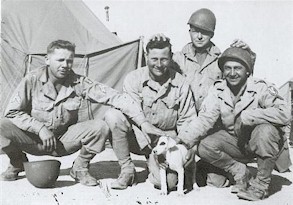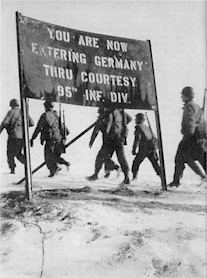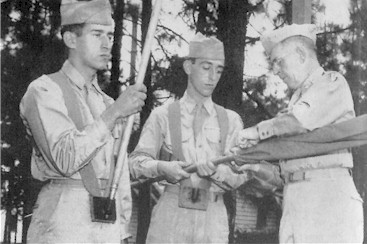|
Its
History
The division
had a brief release of life right at the end of WWI but
was still in training when the armistice intervened and in
December 1918 it was deactivated, although between the
wars it existed as an organized reserve division based in
Oklahoma City. In May 1942, Maj-Geneneral Harry L. Twaddle
was appointed as commander. A cadre of junior officers and
enlisted men began to be posted in and the division was
officially activated at a ceremony in June at Fort Swift,
Texas. It was a triangular division made up of the 377th,
378th and 379th Infantry Regiments, as well as the usual
organic divisional, troops, engineers, artillery, mediacl,
quartermaster etc. To make up the numbers, men from many
backgrounds continued to arrive, predominantly from the
Mid-West and started the usual round of basic training. It
was while at Camp Swift that the insignia was adopted :
the Arabic "9" combined with the Roman
"V".
 |
The
division then followed the basic pattern of all the
new US divisions, moving throughout the country from
camp to camp for maneuvers and specialized training.
The program continued throughout 1943 and into 1944,
and was extremely thorough, including desert and
mountain warfare training. Toward the end of July
the various units began to move by train to Camp
Miles Standish to prepare for employment overseas,
and then to the port of Boston to embarkation.
Crammed on board two troopships, the division
enjoyed an untroubled crossing and on August 14 and
17, docked at Liverpool. From there, they traveled
by train to the Winchester area near the south coast
of England.
|
| July
1944, soldiers from the division join Boston
for a future way in England. |
|
They
stay only lasted about three weeks before they moved
down to Southampton to embark for France and in
mid-September the entire division arrived off Omaha
beach where they were confronted by a first taste of
the devastation of war: sunken ships, abandoned
vehicles and the provisional graves of the fallen.
|
 |
| The
soldiers of the 95th ID US embark on boats to reach
France |
 |
Once
ashore the division moved into bivouac quarters, but
while awaiting assignment to combat, its trucks were
taken to assist in the Red Ball Express. Many of the
men found themselves employed as truck drivers on
the run from Cherbourg via Paris to the front line,
hauling supplies of all description and bringing
back empty jerrycans and German prisoners.
|
| 4
soldiers in bivouac take picture with a dog. |
After about a
month of marking time in the Normandy tents the division
was informed that it would be assigned to Ninth Army and
the various units set off for the front in the Metz sector
both by truck and box-car, arriving in mid-October. When
the advance party arrived, they were informed that the
assignment had changed to XXth "Ghost"
Corps of the Third Army of Patton, since October 14.
 |
After
its quick action, the city of Thionville is
liberated on 11 November 1944 and the division
linked up with the 5th Infantry Division on the
Outskirts of Vallières at 11 o'clock on 18 November
1944. Tanks and Infantry of the division charged
into streets of Metz the next morning to remove
"die hard" resistors. At 14.35 on the
afternoon of 22 November 1944, Maj. Gen. Walton H.
WALKER reported to Lt. Gen. PATTON that Metz was
completely secured.
|
| On
November 18th, 1944, a patrol of the 378th Infantry
Regiment of the 95th ID (right) meets a patrol of
the 5th ID in the South of Vallières in front of
the sign indicating Metz. The surrounding of Metz
was achieved… An hictorical moment ! Now, the
battle of Metz properly speaking could start … |
|
After
playing a leading role in the final reduction of
Metz fortress, the division moved off eastwards
towards the Saar rivers and took part in the
Sarrlautern fighting in the Siegfried Line. At the
beginning of February 1945 the division was
transfered to General Simpson's Ninth Army and moved
to north into Belgium and then into Holland to take
part in the Rhineland campaign know as Operation
Grenade. Once over the Rhine, the 95th Took part in
the operations to reduce the Ruhr Pocket and then
moved eastwards into the heart of defeated Germany
ending up in the Leipzig area on VE Day. This xas
followed by the usual round of occupation duties and
in July 1945, the division sailed for home and
eventual retraining for the War ine the Pacific,
annulled by the dropping of the atomic bombs.
|
 |
| Des
GI's are entering Germany, near Saalautern, sector
of the 95th Inf. Div. |
 |
The 95th
Infantry Division had fought in Europe for nearly 12
months involving 145 days of combat including a
continuous period of more than 100 days. The 95th
Infantry Division captured more than 439 centers of
population, including Germany's ninth largest city,
Dortmund.
It had
left behind ahistory of heroism and bravery and
accolades of friends and ennemy, "Iron Men of
Metz", "The Bravest of Braves ". But
it had also left behinf 6591 officially recorded
casualties.
|
| Le
Général Twaddle saw the Division inactive on 15
October 1945, at Camp Shelby, Mississippi (USA). |
The "Iron
Men of Metz", a title given to them by General Kittel,
the German fortress commander of Metz, were stood down on
15 October and the division returned to its pre-war roles
as an Oklahoma based reserved cadre. The division
continues today in a training roles as the 95th Division
Training Unit, still headquartered in Oklahoma City.
|

